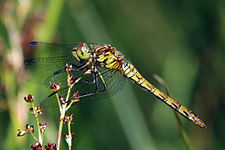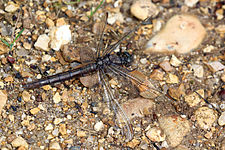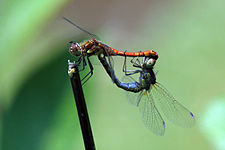
The black-tailed skimmer is a dragonfly belonging to the family Libellulidae.

The migrant hawker is one of the smaller species of hawker dragonflies. It can be found away from water but for breeding it prefers still or slow-flowing water and can tolerate brackish sites. The flight period is from July to the end of October. A. mixta occurs in North Africa, southern and central Europe to the Baltic region.

The red-veined darter or nomad is a dragonfly of the genus Sympetrum.

Libellula depressa, the broad-bodied chaser or broad-bodied darter, is one of the most common dragonflies in Europe and central Asia. It is very distinctive with a very broad flattened abdomen, four wing patches and, in the male, the abdomen becomes pruinose blue.
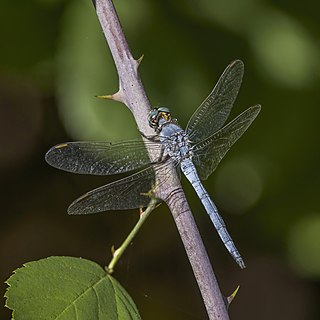
The keeled skimmer is a species of dragonfly belonging to the family Libellulidae.

The large red damselfly is a species of damselflies belonging to the family Coenagrionidae. It is native to the western Palearctic.

The small red-eyed damselfly is a member of the damselfly family Coenagrionidae. It is very similar to the red-eyed damselfly.

The southern hawker or blue hawker is a species of hawker dragonfly.

The ruddy darter is a species of dragonfly of the family Libellulidae.

Sympetrum pedemontanum, the banded darter, is a dragonfly belonging to the genus Sympetrum. It is characterized by its small stature, dark wing bands, and red or yellow body. It lives in areas with low vegetation and stagnant or weakly flowing bodies of water. Although debate exists regarding the taxa's relationship to others in its genus, it can most commonly be identified by its wing bands, bilobed prothorax, and possibly its genitalia.

Sympetrum is a genus of small to medium-sized skimmer dragonflies, known as darters in the UK and as meadowhawks in North America. The more than 50 species predominantly live in the temperate zone of the Northern Hemisphere; 15 species are native to North America. No Sympetrum species is native to Australia.
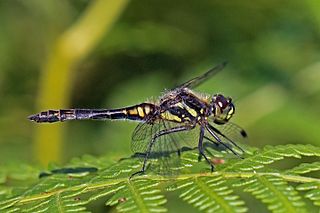
Sympetrum danae, the black darter or black meadowhawk, is a dragonfly found in northern Europe, Asia, and North America. At about 30 mm (1.2 in) long, it is Britain's smallest resident dragonfly. It is a very active late summer insect typical of heathland and moorland bog pools.

The white-legged damselfly or blue featherleg is a damselfly of slow-flowing, muddy waters. It occurs from the Atlantic to Siberia and is often abundant throughout its range.

Trithemis annulata, commonly known as the violet dropwing, violet-marked darter, purple-blushed darter, or plum-coloured dropwing, is a species of dragonfly in the family Libellulidae. It is found in most of Africa, the Middle East, the Arabian Peninsula, and southern Europe. These dragonflies are called dropwings because of their habit of immediately lowering their wings after landing on a perch. Males of this species are violet-red with red veins in the wings, while females are yellow and brown. Both sexes have red eyes.

The white-faced darter or small whiteface is a dragonfly belonging to the genus Leucorrhinia in the family Libellulidae, characterised by red and black markings and a distinctive white patch on the head. It is found in wetlands and peat bogs from northern Europe eastwards to Siberia, and the adults are active from around April till September, which is known as the "flight period". It breeds in acidic bodies of water, laying its eggs in clumps of sphagnum moss that provide a safe habitat for larval development. The larvae are particularly vulnerable to predation by fish, and so are usually found in lakes where fish are not present. L. dubia is listed as a species of least concern (LC) by the IUCN Red List, however, it is potentially threatened by habitat destruction, pollution, and climate change.
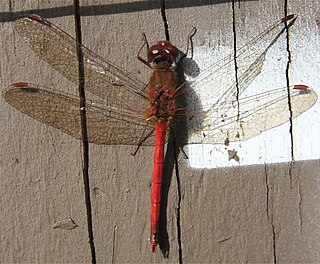
Sympetrum vicinum, the Yellow-Legged Meadowhawk is one of some fifteen North American species of autumn meadowhawk, which are members of the Odonate family Libellulidae. It grows to 26–35 mm long.

The band-winged meadowhawk is a dragonfly of the genus Sympetrum belonging to the family Libellulidae.

Anax parthenope, the lesser emperor, is a dragonfly of the family Aeshnidae. It is found in Southern Europe, North Africa, Middle East and Asia.

Chalcolestes viridis, formerly Lestes viridis, is a damselfly of the family Lestidae. It has a metallic green body and at rest it holds its wings away from its body. Its common name is the willow emerald damselfly, the green emerald damselfly, or the western willow spreadwing. It has an elongated abdomen and pale brown spots on its wings and resides in areas of still water with overhanging trees.

Sympetrum meridionale, the southern darter, is a species of dragonfly belonging to the Skimmer family Libellulidae.





